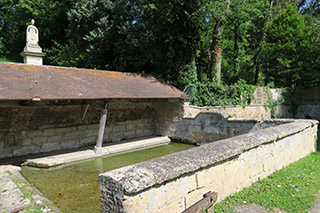Prochain point : lat="49.105384981971255" lon="1.840789738935471"
THE SAINT-ROMAIN LAVOIR AND FOUNTAIN
Small-scale heritage waterworks
Practical...
The lavoir (or wash house) was built on an abundant water source which feeds into the Guiry stream. It is known as the Saint-Romain fountain. Originally, the lavoir was likely no more than a washing trough. At the end of the 1870s, for safety reasons, plans were made to raise the wall of the lavoir to create a proper drinking trough. Until that time, the stream itself served as a communal drinking trough. Construction finished in 1880. The limestone used came from the village quarry, the mortar from the lime kilns and the burrstone from Hazeville. The roof of the lavoir was apparently built in 1895. Old postcards show a zinc roof. However, the roof is now tiled following successive restoration works.
...and miraculous
According to local legend, Saint Romain was born in a castle near this water source, in the hamlet of “les Rochettes” around 585. The ruins of this dwelling were still visible in 1819. From an aristocratic family, Romain was educated at the court of the Merovingian king, Clothar the 2nd. He became archbishop of Rouen in 626. Saint Romain was said to have built a hospital for poor travellers near the water source. He is also credited with founding the chapel that preceded the village church. During his lifetime, he performed “miracles” that survive in legend today. Saint Romain died on October 23, 635. This date became the day of Saint Romain and was long celebrated in the town. The clergy, along with the archbishop of Rouen, priests and locals from neighbouring parishes, would form a procession to the water source. A small, 15th century, wooden statue of Saint Romain, since kept at the Guiry village church, was dipped into the water and blessed. Many faithful filled bottles with water from the source which was said to prevent hail and also cure colds. In 1858, the 15th century statue was replaced by another statue, sculpted by Father Dheilly, priest of Genainville.




